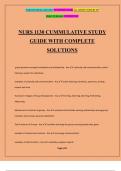©GRACEAMELIA 2024/2025 ACADEMIC YEAR. ALL RIGHTS RESERVED
FIRST PUBLISH OCTOBER 2024
NURS 1130 CUMMULATIVE STUDY
GUIDE WITH COMPLETE
SOLUTIONS
group dynamics and goal completion are facilitated by - Ans:✔✔-culturally safe communication, active
listening, respect for individuals
examples of culturally safe communication - Ans:✔✔-active listening, timeliness, openness, sharing,
respect and trust
Tuckman's 5 Stages of Group Development - Ans:✔✔-Forming, Storming, Norming, Performing,
Adjourning
Maintenance Functions of groups - Ans:✔✔-activities that facilitate working relationships among group
members and increase personal satisfaction
Task Functions of Groups - Ans:✔✔-activities that keep the group moving towards their goals
example of maintenance function - Ans:✔✔-encourage communication
examples of task functions - Ans:✔✔-schedules, progress reports
Page 1/41
, ©GRACEAMELIA 2024/2025 ACADEMIC YEAR. ALL RIGHTS RESERVED
FIRST PUBLISH OCTOBER 2024
2 types of skills that all groups require - Ans:✔✔-interpersonal, managerial
leadership - Ans:✔✔-the ability to define a vision and guide individuals and groups towards that vision
while maintaining the group-promoting teamwork, commitment and effectiveness
leadership responsibilities - Ans:✔✔-identify & examine responsibilities related to group leadership
within small groups
effective feedback for group work - Ans:✔✔-focus on behavior, stay with the important issues, use a
manner of respect, balance strengths and weaknesses, be realistic and timely
collaborative practice - Ans:✔✔-working together towards mutually identified goals while valuing
different perspectives and accountabilities of different team members
2 types of collaborative practice - Ans:✔✔-intraprofessional and interprofessional
intraprofessional - Ans:✔✔-working with different levels of nurses
interprofessional - Ans:✔✔-members of different health disciplines working together
collaborative practice is associated with - Ans:✔✔-improved client outcomes, reduced medication errors,
improved coordination of care, improved team communication, efficient use of resources
consensus - Ans:✔✔-all members agree to support the decision
Page 2/41
, ©GRACEAMELIA 2024/2025 ACADEMIC YEAR. ALL RIGHTS RESERVED
FIRST PUBLISH OCTOBER 2024
reasons nurses may have difficulty talking about spirituality - Ans:✔✔-uncertain, concern they may not
have the right words, little spiritual education in nursing school, someone else's responsibilities
things that spirituality influences - Ans:✔✔-beliefs and values, perception and interpretations, self-
concept
CNA definition of spirituality - Ans:✔✔-a connectedness with self, others, and the sacred that transcends
and empowers the self
spiritual well-being - Ans:✔✔-a state of wholeness or health. Spiritual health is enhanced when people
find a balance between their life values, goals, and belief systems and their relationship within
themselves and with others
religion - Ans:✔✔-organized spiritual belief system, provides an outward expression of spirituality,
maintains beliefs through action
2 components of faith - Ans:✔✔-belief and action
belief - Ans:✔✔-relationship with a higher power
action - Ans:✔✔-lifestyle choices based on personal beliefs
hope - Ans:✔✔-a multidimensional concept that provides comfort while people endure life threats and
personal challenges
Page 3/41
, ©GRACEAMELIA 2024/2025 ACADEMIC YEAR. ALL RIGHTS RESERVED
FIRST PUBLISH OCTOBER 2024
transcendence - Ans:✔✔-an awareness of something that a person cannot know in ordinary physical
ways
how to provide spiritual care - Ans:✔✔-support personal practices, use good communication skills
self concept - Ans:✔✔-the mental image one has of oneself
Erikson's Developmental Tasks - Ans:✔✔-Trust vs Mistrust, Autonomy vs shame and doubt, initiative vs
guilt, industry vs interiority, identity vs role confusion, intimacy vs isolation, generativity vs self-
absorption, ego integrity vs despair
Trust vs mistrust - Ans:✔✔-birth to age 1, develops trust from consistency in caregiving and nurturing
interactions of parents and others, distinguishes self from environment
autonomy vs shame and doubt - Ans:✔✔-age 1-3, begins to communicate likes and dislikes, increasingly
autonomous in thoughts and actions, appreciates body appearances and functions, develops self
through modelling, imitation and socialization
initiative vs guilt - Ans:✔✔-age 3-6, identifies with gender, enhance self awareness, takes initiative,
language skills, identifies feelings, sensitive to family feedback
industry vs inferiority - Ans:✔✔-ages 6-12, incorporates feedback from peers and teachers, increases
self-esteem with new skill mastery, experiences strengthening of sexual identity, aware of strengths and
limitations
Page 4/41




